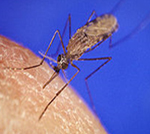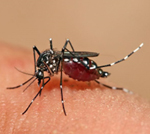| Malaria |
|
Approximately half of the world's population is at risk of malaria. Most malaria cases and deaths occur in sub-Saharan Africa. However, Asia, Latin America, and to a lesser extent the Middle East and parts of Europe are also affected. In 2008, malaria was present in 108 countries and territories.
According to the World Health Organization (WHO), "in 2008, there were an estimated 243 million cases of malaria worldwide. The majority of cases were in the WHO African Region (85%), followed by the WHO South-East Asia Region (10%) and the WHO Eastern Mediterranean Region (4%). Malaria accounted for an estimated 863, 000 deaths in 2008, of which 89% were in the WHO African Region, followed by the WHO Eastern Mediterranean (6%) and South-East Asia (5%) regions. The majority (85%) of deaths were in children under five years of age."
Key interventions to control malaria include the use of Bio Larvicides BTI and insecticidal nets by people at risk and indoor residual spraying with insecticide to control the vector mosquitoes.
Malaria is caused by a parasite called Plasmodium, which is transmitted via the bites of infected Anopheles mosquitoes. In the human body, the parasites multiply in the liver, and then infect red blood cells.
Symptoms of malaria include fever, headache, and vomiting, and usually appear between 10 and 15 days after the mosquito bite. If not treated, malaria can quickly become life-threatening by disrupting the blood supply to vital organs.
|
 |
| Dengue |
|
“With more than one-third of the world’s population living in areas at risk for transmission, dengue infection is a leading cause of illness and death in the tropics and subtropics. As many as 100 million people are infected yearly. Dengue is caused by any one of four related viruses transmitted by mosquitoes.
There are not yet any vaccines to prevent infection with dengue virus and the most effective protective measures are those that avoid mosquito bites. When infected, the early recognition and prompt supportive treatment can substantially lower the risk of developing severe disease.” (Source: Centers for Disease Control)
According to the World Health Organization (WHO), Dengue, also known as Break Bone Fever due to the pain it causes, “is transmitted by the bite of an Aedes mosquito infected with any one of the four dengue viruses. Symptoms appear in 3–14 days (average 4–7 days) after the infective bite. Dengue fever is a severe, flu-like illness that affects infants, young children and adults. There is no specific treatment for dengue fever. Dengue hemorrhagic fever is a potentially lethal complication but early clinical diagnosis and careful clinical management by experienced physicians and nurses often save lives.
More than 70% of the disease burden is in South-East Asia and the Western Pacific area. Africa and the Eastern Mediterranean are much less affected. In Latin America and the Caribbean, the incidence and severity of disease are increasing rapidly. Increase in international air travel is facilitating the rapid global movement of dengue viruses. This increases the risk of dengue hemorrhagic fever epidemics by introducing new dengue viruses into susceptible populations."
|
 |
| Yellow Fever |
|
Yellow fever is a viral disease, found in tropical regions of Africa and the Americas. It is transmitted via the bite of Aedes mosquitoes. It can produce devastating outbreaks, which can be prevented and controlled by mass vaccination campaigns.
The first symptoms of the disease usually appear 3–6 days after infection. The first, or “acute”, phase is characterized by fever, muscle pain, headache, shivers, loss of the appetite, nausea and vomiting. After 3–4 days, most patients improve and symptoms disappear. However, in a few cases, the disease enters a “toxic” phase: fever reappears, and the patient develops jaundice and sometimes bleeding, with blood appearing in the vomit (the typical "vomito negro"). About 50% of patients who enter the toxic phase die within 10–14 days.
There is no specific treatment for yellow fever. Vaccination is highly recommended as a preventive measure for travelers to, and people living in, endemic countries.
|
 |
| Filariasis |
|
Lymphatic filariasis is infection with the filarial worms, Wuchereria bancrofti, Brugia malayi or B. timori. These parasites are transmitted to humans through the bite of an infected mosquito and develop into adult worms in the lymphatic vessels, causing severe damage and swelling (lymphoedema). Elephantiasis – painful, disfiguring swelling of the legs and genital organs – is a classic sign of late-stage disease.
The infection can be treated with drugs. However, chronic conditions may not be curable by anti-filarial drugs and require other measures, e.g. surgery for hydrocele, care of the skin and exercise to increase lymphatic drainage in lymphoedema.
Lymphatic filariasis is a leading cause of permanent disability worldwide. Communities frequently shun and reject women and men disfigured by the disease. Affected people frequently are unable to work because of their disability, and this harms their families and their communities.
Filariasis is considered endemic in tropical and sub-tropical regions of Asia, Africa, Central, South America and Pacific Island nations, with more than 120 million people infected and one billion people at risk for infection.
Of 81 countries listed by WHO as being endemic for lymphatic filariasis, 68 countries have completed mapping their endemic foci, 11 countries have made progress and 2 have y
|
 |
|
|

